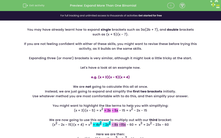You may have already learnt how to expand single brackets such as 3a(2b + 7), and double brackets such as (x + 5)(x - 7).
If you are not feeling confident with either of these skills, you might want to revise these before trying this activity, as it builds on the same skills.
Expanding three (or more!) brackets is very similar, although it might look a little tricky at the start.
Let's have a look at an example now.
e.g. (x + 3)(x - 5)(x + 4)
We are not going to calculate this all at once.
Instead, we are just going to expand and simplify the first two brackets initially.
Use whatever method you are most comfortable with to do this, and then simplify your answer.
You might want to highlight the like terms to help you with simplifying:
(x + 3)(x - 5) = x2 + 3x - 5x - 15 = x2 - 2x - 15
We are now going to use this answer to multiply out with our third bracket:
(x2 - 2x - 15)(x + 4) = x3 + 4x2 - 2x2 - 8x -15x - 60 = x3 + 2x2 - 23x - 60
Here we are then:
(x + 3)(x - 5)(x + 4) = x3 + 2x2 - 23x - 60
The key to success with these questions is to take our time to expand each set of brackets carefully.
In this activity, we are going to expand triple sets of brackets to reach the simplest possible expression using the method described above.
You may want to have a pen and paper handy to keep track of your working.
Don't rush it; it's easy to make a mistake with so many terms, different powers and signs to think about!







